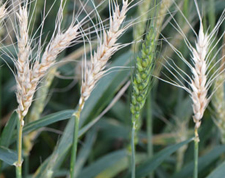CropWatch June 7, 2013 - Index of Articles
 Wheat Updates
Wheat Updates
Bleached heads of wheat can indicate several problems; in this case — damage from a late spring freeze. See this week's Nebraska Disease Update and the crop and PPDC reports for more information.
June 7, 2013
Corn Production
- Scouting for Common Stalk Borers. This week's degree day accumulations indicate that growers in southeast Nebraska, counties bordering Kansas and the far western Panhandle should be scouting for stalk borers. Learn more about the stalk borer life cycle, management, and economic thresholds.
- USDA Research: Encapsulating Nematodes to Battle Corn Pests
Wheat Production
- Wheat Disease Update. Risk for rusts and scab remains low. Powdery mildew and fungal leaf spots are the predominant diseases in eastern Nebraska.
- Wheat Program and Plot Tour June 11 in Furnas County
Weed Management
- Tips for Applying Residual Herbicides after Soybean Emergence. With a compressed spring, many growers may be applying residual herbicides after soybean emergence. Learn what to consider and features of several residual herbicides.
Pest Management
Pasture and Range Management
- Continued Good News for Grasshopper Risk on Rangeland. While the risk of grasshopper damage in rangeland is low compared to other years, isolated pockets could cause serious damage and scouting is recommended for indicated areas.
Alfalfa Production
- Managing Temptations and Avoiding Shortcuts. Feeling pressed to get everything done? Watch out for shortcuts that can have long-term impacts.
- Preservatives Allow for Wetter Hay Harvest
- Maximizing Alfalfa Tonnage
Market Journal
- Market Journal Looks at
— Wheat market
— Potential nitrogen leaching
— Sampling for corn nematodes
— Potential Pythium development
— Pasture production
— Weather forecast
Crop Reports
- Western Nebraska Crop Reports
- Planters Press to Get 81% of the Soybean Crop in the Ground
- USDA NASS: Soybean Planting Nearly Done; 50% of State's Wheat Very Poor to Poor
On this week's Market Journal Tamra Jackson-Ziems discusses potential impact from corn nematodes, a pest found in every U.S. corn field, and how you can sample and identify the risk in your fields.